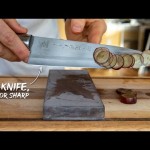
efbedc067c69aebfdb8c4e65b152a8a8
Do you have an old pocket knife that you want to restore to its former glory? Restoring a pocket knife can be a rewarding experience, and with the right tools and knowledge, it can be done with relative ease. In this article, we will provide a step-by-step guide on how to restore a pocket knife, from cleaning and sharpening to polishing and oiling. With this guide, you will be able to bring your pocket knife back to life and make it look as good as new.
Can you use wd40 on a pocket knife
WD-40 is a multi-purpose lubricant and cleaner that is used for a variety of tasks. It is often used to lubricate and protect metal surfaces, and it can also be used to clean and protect tools. But can you use WD-40 on a pocket knife?
The answer is yes, you can use WD-40 on a pocket knife. WD-40 is a great lubricant for pocket knives, as it helps to keep the blade moving smoothly and prevents rust and corrosion. It can also be used to clean the blade and handle of the knife, as it is a powerful cleaner that can remove dirt and grime. However, it is important to note that WD-40 is not a lubricant that should be used on a regular basis, as it can cause the blade to become sticky and difficult to open and close.
When using WD-40 on a pocket knife, it is important to make sure that the blade is completely dry before applying the lubricant. This will help to ensure that the lubricant does not cause any damage to the blade or handle. It is also important to make sure that the WD-40 is applied in a thin layer, as too much can cause the blade to become sticky and difficult to open and close. Once the WD-40 has been applied, it is important to wipe off any excess with a clean cloth.
In conclusion, WD-40 can be used on a pocket knife, but it should only be used sparingly. It is important to make sure that the blade is completely dry before applying the lubricant, and that it is applied in a thin layer. WD-40 can help to keep the blade moving smoothly and prevent rust and corrosion, but it should not be used on a regular basis.
Can you soak a pocket knife in vinegar
Soaking a pocket knife in vinegar is a great way to clean and disinfect it. Vinegar is a natural disinfectant and can help remove dirt, grime, and rust from the blade. It can also help to remove any bacteria or germs that may be present on the knife. However, it is important to note that soaking a pocket knife in vinegar can damage the blade if done incorrectly.
How to Soak a Pocket Knife in Vinegar
Before soaking a pocket knife in vinegar, it is important to make sure that the blade is completely dry. Any moisture on the blade can cause the vinegar to react with the metal and cause corrosion. Once the blade is dry, it can be soaked in a bowl of vinegar for up to an hour. After the soaking time is complete, the blade should be rinsed off with warm water and dried thoroughly.
It is also important to note that vinegar can damage some types of pocket knives. Knives with wooden handles or blades made of softer metals such as aluminum or brass should not be soaked in vinegar. If the knife is made of stainless steel, it should be safe to soak in vinegar.
Conclusion
Soaking a pocket knife in vinegar is a great way to clean and disinfect it. However, it is important to make sure that the blade is completely dry before soaking and that the knife is made of stainless steel. If done correctly, soaking a pocket knife in vinegar can help to remove dirt, grime, and rust from the blade and help to remove any bacteria or germs that may be present on the knife.
Can knives be restored
Knives are essential tools for many tasks, from cutting food to opening packages. Over time, however, knives can become dull and damaged.
Fortunately, knives can often be restored to their original condition with a few simple steps.
Sharpening
The most common way to restore a knife is to sharpen it. This involves using a sharpening stone or other sharpening tool to remove small amounts of metal from the blade. This process can be done by hand or with an electric sharpener. It is important to use the correct sharpening angle and technique to ensure that the blade is sharpened evenly.
Cleaning
Cleaning a knife is also important for restoring it. This involves removing dirt, rust, and other debris from the blade. This can be done with a soft cloth and a mild detergent. It is important to be gentle when cleaning a knife, as harsh scrubbing can damage the blade.
Polishing
Polishing a knife can also help to restore its original condition. This involves using a polishing compound to remove scratches and other imperfections from the blade. This process can be done by hand or with an electric polisher. It is important to use the correct polishing technique to ensure that the blade is polished evenly.
Replacement Parts
In some cases, a knife may need to be restored by replacing parts. This may include replacing the handle, blade, or other components. It is important to use the correct replacement parts to ensure that the knife is restored properly.
Conclusion
Knives can often be restored to their original condition with a few simple steps. Sharpening, cleaning, polishing, and replacing parts can all help to restore a knife. It is important to use the correct techniques and replacement parts to ensure that the knife is restored properly.
What is the hook on the back of a pocket knife for
Pocket knives are a popular tool for everyday use. They are small, lightweight, and easy to carry. But what is the hook on the back of a pocket knife for?
The hook, or lanyard hole, is a small hole located at the end of the handle of a pocket knife. It is used to attach a lanyard, which is a cord or strap that can be used to secure the knife to a belt loop or other item. This allows the user to keep the knife close at hand and prevents it from being lost or misplaced.
The lanyard hole can also be used to attach a carabiner or other clip, which can be used to attach the knife to a backpack or other item. This makes it easier to carry the knife and prevents it from being lost or misplaced.
The lanyard hole can also be used to attach a keychain or other item, which can be used to keep the knife close at hand. This is especially useful for people who need to carry a pocket knife with them at all times.
The lanyard hole is a useful feature of pocket knives and can be used in a variety of ways. It is a great way to keep the knife close at hand and prevents it from being lost or misplaced.
We hope this guide has been helpful in restoring your pocket knife. With a few simple steps, you can have your pocket knife looking and functioning like new. Goodbye and good luck!















